Roman Catholic
St Sigismund parish
05-507 Słomczyn
85 Wiślana Str.
Konstancin deanery
Warsaw archdiocese, Poland
full list:
displayClick to display full list

searchClick to search full list by categories
wyświetlKliknij by wyświetlić pełną listę po polsku

szukajKliknij by przeszukać listę wg kategorii po polsku

Martyrology of the clergy — Poland
XX century (1914 – 1989)
personal data
surname
PIOTROWSKI
forename(s)
Ignatius (pl. Ignacy)
function
diocesan priest
creed
Latin (Roman Catholic) Church RCmore on
en.wikipedia.org
[access: 2014.09.21]
diocese / province
Gniezno and Poznań archdiocese (aeque principaliter)more on
www.archpoznan.pl
[access: 2012.11.23]
RC Military Ordinariate of Polandmore on
en.wikipedia.org
[access: 2014.12.20]
date and place
of death
09.02.1942

KL Posenconcentration camp
today: Poznań, Poznań city pov., Greater Poland voiv., Poland
more on
en.wikipedia.org
[access: 2022.01.09]
details of death
During ministry in Czarnków 1909‐1912 founded the Society of Catholic Servants. Accused by the Prussian authorities of establishing a political organization. Tried but acquitted in the court of appeal.
In 1911‐1912 took part in the election campaign to the Germ. Reichstag (Eng. Reich Parliament) of the German Empire — elections took place in 1912 — in the Germ. Kreis Czarnikau (Eng. Czarnków County), part of the Prussian part of partitioned Poland, i.e. Germ. Provinz Posen (Eng. Poznań Province), supporting Polish candidates. Participated in election rallies on 17.12.1911 in Czarnków and 01.01.1912 in Lubasz.
In 1915, drafted into the German Imperial Army. According to sources, was to be a chaplain at the „field hospital of the 75th Division from Wschowa”. In the German army, there was the Germ. 75. Reserve‐Division, formed in central Germany, which in 1915‐1917 — the triumph of the Central Powers (Germany and Austria–Hungary) in the Battle of Gorlice on c. 05.05.1915 — fought against the Russians, among others.
on the line of the Narew River, Białystok, Grodno and Vilnius, then occupying part of the front line in the area of Lake Naroch in Belarus, to be transferred to Kovel during the Russian Brusilov offensive of 04.06.1916‐20.09.1916, and then to occupy the front line in Eastern Galicia between Naraivka and Zolota Lypa. It is possible that this division ran a field hospital in Wschowa for some time. Meanwhile, in Wschowa itself, the Prussian Germ. 3. Posensches Infanterie–Regiment Nr. 58 (Eng. 3rd Poznań Infantry Regiment No. 58) was formed, which fought on the Western Front, including in the battles for Verdun — along the road Fr. Tranchée de Calonne (Eng. Tranchee of Callone) and at Les Éparges — on the Meuse and Moselle, and during the Second Battle of the Aisne.
In 1920, during the Polish–Russian War of 1919‐1921, prob. chaplain of the Polish Army (possibly in the Gniezno garrison command). In 01.1921, released and verified as a reserve chaplain, with seniority from 01.06.1919, in the rank of captain.
Also later, in 1923, 1924, 1925, 1927 and 1929 appointed reserve chaplain of the Polish Army (from 25.11.1926 each time for a statutory 2‐year period).
After German invasion of Poland on 01.09.1939 (Russians invaded Poland 17 days later) and start of the World War II, after start of German occupation, interned by the Germans on 08.09.1939 — on the day of town capture and start of German occupation — as a hostage.
Released a day later.
Arrested again by the Germans on 22.08.1941.
Jailed in KL Posen (Fort VII) concentration camp where perished.
According to the death certificate in the registers of the civil registry office in Poznań, No. P 585/1942, the „honest” otherwise German „medical doctors” and formalists — and at the same time, unrivaled fairy tale spinners — noted the cause of death was „senile weakness”.
cause of death
murder
perpetrators
Germans
sites and events
KL PosenClick to display the description, «Intelligenzaktion»Click to display the description, Reichsgau WarthelandClick to display the description, Collective responsibility („Hostages”)Click to display the description, Ribbentrop‐MolotovClick to display the description, Pius XI's encyclicalsClick to display the description, Polish‐Russian war of 1919‐1921Click to display the description
date and place
of birth
10.07.1882Birth certification on:
photos.szukajwarchiwach.gov.pl
[access: 2025.08.19]

Koźmintoday: Koźmin Wielkopolski, Koźmin Wielkopolski gm., Krotoszyn pov., Greater Poland voiv., Poland
more on
en.wikipedia.org
[access: 2021.05.20]
parents
PIOTROWSKI John
🞲 ?, ? — 🕆 ?, ?

WARKOCKA Anastasia
🞲 ?, ? — 🕆 ?, ?
presbyter (holy orders)
ordination
14.02.1909

Gnieznotoday: Gniezno urban gm., Gniezno pov., Greater Poland voiv., Poland
more on
en.wikipedia.org
[access: 2021.12.18]
Assumption of the Blessed Virgin Mary RC archcathedral churchmore on
en.wikipedia.org
[access: 2025.03.14]
positions held
c. 1934 – 1941
dean — Nowe Miasto nad Wartątoday: Nowe Miasto nad Wartą gm., Środa Wielkopolska pov., Greater Poland voiv., Poland
more on
en.wikipedia.org
[access: 2020.11.27] RC deanery
1928 – 1941
parish priest — Książ Wielkopolskitoday: Książ Wielkopolski gm., Śrem pov., Greater Poland voiv., Poland
more on
en.wikipedia.org
[access: 2020.11.27] ⋄ Blessed Virgin Mary of the Assumption and St Nicholas the Bishop and Confessor RC parish ⋄ Nowe Miasto nad Wartątoday: Nowe Miasto nad Wartą gm., Środa Wielkopolska pov., Greater Poland voiv., Poland
more on
en.wikipedia.org
[access: 2020.11.27] RC deanery — also: c. 1934 deanery notary
1929 – 1941
administrator — Gogolewotoday: Książ Wielkopolski gm., Śrem pov., Greater Poland voiv., Poland
more on
en.wikipedia.org
[access: 2021.07.18] ⋄ Exaltation of the Holy Cross RC parish ⋄ Nowe Miasto nad Wartątoday: Nowe Miasto nad Wartą gm., Środa Wielkopolska pov., Greater Poland voiv., Poland
more on
en.wikipedia.org
[access: 2020.11.27] RC deanery — acting („ad interim”)
1937
administrator — Kolniczkitoday: Nowe Miasto nad Wartą gm., Środa Wielkopolska pov., Greater Poland voiv., Poland
more on
en.wikipedia.org
[access: 2025.01.04] ⋄ Nativity of the Blessed Virgin Mary RC parish ⋄ Nowe Miasto nad Wartątoday: Nowe Miasto nad Wartą gm., Środa Wielkopolska pov., Greater Poland voiv., Poland
more on
en.wikipedia.org
[access: 2020.11.27] RC deanery — acting („ad interim”)
1934
administrator — Radlintoday: Jarocin gm., Jarocin pov., Greater Poland voiv., Poland
more on
en.wikipedia.org
[access: 2021.12.18] ⋄ St Valentine Priest and Martyr RC parish ⋄ Nowe Miasto nad Wartątoday: Nowe Miasto nad Wartą gm., Środa Wielkopolska pov., Greater Poland voiv., Poland
more on
en.wikipedia.org
[access: 2020.11.27] RC deanery — acting („ad interim”)
1934
administrator — Mieszkówtoday: Jarocin gm., Jarocin pov., Greater Poland voiv., Poland
more on
en.wikipedia.org
[access: 2021.07.15] ⋄ St Lawrence the Martyr RC parish ⋄ Nowe Miasto nad Wartątoday: Nowe Miasto nad Wartą gm., Środa Wielkopolska pov., Greater Poland voiv., Poland
more on
en.wikipedia.org
[access: 2020.11.27] RC deanery — acting („ad interim”)
1919 – c. 1927
parish priest — Lechlintoday: Skoki gm., Wągrowiec pov., Greater Poland voiv., Poland
more on
en.wikipedia.org
[access: 2021.07.18] ⋄ St Stanislav the Bishop and Martyr RC parish ⋄ Rogoźnotoday: Rogoźno gm., Oborniki pov., Greater Poland voiv., Poland
more on
en.wikipedia.org
[access: 2021.07.18] RC deanery — prob. with a break for pastoral service in the Polish Armed Forces during the Polish–Russian war of 1919‐1921
1917 – 1918
vicar — Środatoday: Środa Wielkopolska, Środa Wielkopolska gm., Środa Wielkopolska pov., Greater Poland voiv., Poland
more on
en.wikipedia.org
[access: 2021.06.20] ⋄ Assumption of the Blessed Virgin Mary RC collegiate parish ⋄ Środatoday: Środa Wielkopolska, Środa Wielkopolska gm., Środa Wielkopolska pov., Greater Poland voiv., Poland
more on
en.wikipedia.org
[access: 2021.06.20] RC deanery
1915 – c. 1917
RC military chaplain — Wschowatoday: Wschowa gm., Wschowa pov., Lubusz voiv., Poland
more on
en.wikipedia.org
[access: 2021.07.18] ⋄ military hospital, German Imperial Army
1912 – c. 1915
vicar — Gostyńtoday: Gostyń gm., Gostyń pov., Greater Poland voiv., Poland
more on
en.wikipedia.org
[access: 2021.07.18] ⋄ St Margaret the Virgin and Martyr RC parish ⋄ Śremtoday: Śrem gm., Śrem pov., Greater Poland voiv., Poland
more on
en.wikipedia.org
[access: 2021.07.18] RC deanery
1909 – 1912
vicar — Czarnkówtoday: Czarnków gm., Czarnków/Trzcianka pov., Greater Poland voiv., Poland
more on
en.wikipedia.org
[access: 2021.06.20] ⋄ St Mary Magdalene RC parish ⋄ Czarnkówtoday: Czarnków gm., Czarnków/Trzcianka pov., Greater Poland voiv., Poland
more on
en.wikipedia.org
[access: 2021.06.20] RC deanery
till 1909
student — Gnieznotoday: Gniezno urban gm., Gniezno pov., Greater Poland voiv., Poland
more on
en.wikipedia.org
[access: 2021.12.18] ⋄ philosophy and theology, Archbishop's Practical Theological Seminary (Lat. Seminarium Clericorum Practicum)
from c. 1905
student — Poznańtoday: Poznań city pov., Greater Poland voiv., Poland
more on
en.wikipedia.org
[access: 2021.07.18] ⋄ philosophy and theology, Archbishop's Theological Seminary (Collegium Leoninum)
others related
in death
CEGIEŁClick to display biography Thaddeus Vladimir Cornelius, FLACHClick to display biography Julian, GRAMLEWICZClick to display biography Edward, HARASYMOWICZClick to display biography Vincent, JANICKIClick to display biography Stanislav, JANKOWSKIClick to display biography Alphonse, KUBIKClick to display biography Alexander, ŁUKOWSKIClick to display biography Steven, MAŁECKIClick to display biography Stanislav, MANITIUSClick to display biography Gustav, MIROCHNAClick to display biography Steven Marian (Fr Julian), MZYKClick to display biography Louis, NIEDBAŁClick to display biography Anthony Marian, NOWAKClick to display biography Francis Joseph, POPRAWSKIClick to display biography Marian, SĘKIEWICZClick to display biography Mauritius Vaclav, STEINMETZClick to display biography Paul, SZREYBROWSKIClick to display biography Casimir, TYMAClick to display biography Joseph, WIŚNIEWSKAClick to display biography Mary, WOŹNIAKClick to display biography Albin
sites and events
descriptions
KL Posen: German Posen — Fort VII — camp founded in c. 10.10.1939 in Poznań till mid of 11.1939 operated formally as Germ. Konzentrationslager (Eng. concentration camp) KL Posen, and this term is used throughout the White Book, also later periods. It was first such a concentration camp set up by the Germans on Polish territory — in case of Greater Poland (Wielkopolska) directly incorporated into German Reich. In 10.1939 in KL Posen for the first time Germans used gas to murder civilian population, in particular patients of local psychiatric hospitals. From 11.1939 the camp operated as German political police Gestapo prison and transit camp (Germ. Übergangslager), prior to sending off to concentration camps, such as KL Dachau or KL Auschwitz. In 28.05.1941 the camp was rebranded as police jail and slave labour corrective camp (Germ. Arbeitserziehungslager). At its peak up to 7‐9 executions were carried in the camp per day, there were mass hangings of the prisoners and some of them were led out to be murdered elsewhere, outside of the camp. Altogether in KL Posen Germans exterminated approx. 20,000 inhabitants of Greater Poland (Wielkopolska) region, including many representatives of Polish intelligentsia, patients and staff of psychiatric hospitals and dozen or so Polish priests. Hundreds of priests were held there temporarily prior to transport to other concentration camps, mainly KL Dachau. From 03.1943 the camp had been transformed into an industrial complex (from 25.04.1944 — Telefunken factory manufacturing radios for submarines and aircrafts). (more on: www.wmn.poznan.plClick to attempt to display webpage
[access: 2019.02.02], en.wikipedia.orgClick to attempt to display webpage
[access: 2013.12.27])
«Intelligenzaktion»: German: «Intelligenzaktion» (English: „Intelligence Action”) — a German program of extermination of the Polish elite, mainly the intelligentsia and leadership layers, carried out from the beginning of the occupation in w 09.1939 to 04.1940, mainly in territories directly annexed to Germany, but also in the so‐called Germ. Generalgouvernement (Eng. General Governorate), where it was called «AB‐aktion». In the first phase, immediately after the beginning of the German occupation, during military operations carried out by the Germ. Wehrmacht (Eng. Armed Forces) and the genocidal units of the Germ. Einsatzgruppen (Eng. Operational Groups) of the Germ. Sicherheitspolizei (Eng. Security Police), i.e. SiPo, and Germ. Sicherheitsdienst des Reichsführers SS (Eng. Security Service of the Reichsführer SS), i.e. SD, organized by the Germ. Reichssicherheitshauptamt (Eng. Reich Main Security Office), i.e. RSHA, which followed the troops, carried out under the Germ. Unternehmen „Tannenberg” (Eng. Operation „Tannenberg”) — based on the so‐called Germ. Sonderfahndungsliste (Eng. Special Wanted Lists), i.e. proscription lists of Poles considered particularly dangerous to the Third Reich, prepared by the Zentralstelle II/P (Polen) unit of the German RSHA. Later, implemented by the German civilian occupation authorities and the genocidal unit of the Germ. Volksdeutscher Selbstschutz (Eng. Ethnic Germans Self‐Defense), whose members were Germ. Volksdeutsche (Eng. Ethnic Germans), i.e. representatives of the German minority in Poland. According to various sources, these lists, at the beginning of 09.1939, could have contained the details of 61,000—88,000 „dangerous” Poles — although these figures cannot be confirmed. In total, during this genocide, c. 50,000 teachers, Catholic priests, representatives of the landed gentry, freelancers, social and political activists, and retired military personnel were systematically and methodically murdered. Another 50,000 were sent to concentration camps, where only a negligible percentage survived. (more on: en.wikipedia.orgClick to attempt to display webpage
[access: 2014.10.04])
Reichsgau Wartheland: After the Polish defeat in the 09.1939 campaign, which was the result of the Ribbentrop‐Molotov Pact and constituted the first stage of World War II, and the beginning of German occupation in part of Poland (in the other, eastern part of Poland, the Russian occupation began), the Germans divided the occupied Polish territory into five main regions (and a few smaller). The largest one was transformed into Germ. Generalgouvernement (Eng. General Governorate), intended exclusively for Poles and Jews and constituting part of the so‐called Germ. Großdeutschland (Eng. Greater Germany). Two were added to existing German provinces. From two other separate new provinces were created. Greater Poland region was one of them, incorporated into Germany on 08.10.1939, by decree of the German leader Adolf Hitler (formally came into force on 26.10.1939), and on 24.01.1940 transformed into the Germ. Reichsgau Wartheland (Eng. Wartheland Reich Province), in which the law of the German state was to apply. The main axis of the policy of the new province, the territory of which the Germans recognized as the Germ. „Ursprünglich Deutsche” (Eng. „natively German”), despite the fact that 90% of its inhabitants were Poles, was Germ. „Entpolonisierung” (Eng. „Depolonisation”), i.e. forced Germanization. C. 100,000 Poles were murdered as part of the Germ. „Intelligenzaktion”, i.e. extermination of Polish intelligentsia and ruling classes. C. 630,000 were forcibly resettled to the Germ. Generalgouvernement, and their place taken by the Germans brought from other areas occupied by Germany (e.g. the Baltic countries, Bessarabia, Bukovina, etc.). Poles were forced to sign the German nationality list, the Germ. Deutsche Volksliste DVL. As part of the policy of „Ohne Gott, ohne Religion, ohne Priesters und Sakramenten” (Eng. „No God, no religion, no priest or sacrament”) most Catholic priests were arrested and sent to concentration camps. All schools teaching in Polish, Polish libraries, theaters and museums were closed. Polish landed estates confiscated. To further reduce the number of the Polish population, Poles were sent to forced labor deep inside Germany, and the legal age of marriage for Poles was increased (25 for women, 28 for men). The German state office, Germ. Rasse‐ und Siedlungshauptamt (Eng. Main Office of Race and Settlement) RuSHA, under the majesty of German law, abducted several thousand children who met specific racial criteria from Polish families and subjected them to forced Germanization, handing them over to German families. After the end of hostilities of World War II, the overseer of this province, the Germ. Reichsstatthalter (Eng. Reich Governor) and the Germ. Gauleiter (Eng. district head) of the German National Socialist Party, Arthur Karl Greiser, was executed. (more on: en.wikipedia.orgClick to attempt to display webpage
[access: 2024.06.21])
Collective responsibility („Hostages”): A criminal practice implemented by the Germans in the occupied territories of Poland, applied from the very first day of World War II. At its core was an appointment and public announcement of a list of names of selected people whose lives depended on absolute compliance with German orders. Any violation of these ordinances, by any person, regardless of the circumstances, resulted in the murder of the designated „hostages”. In the first days of the war and occupation, it was used i.a. by the German Wehrmacht army to prevent acts of continuation of the defense by the Poles. Later, especially in the German‐run General Governorate, it was part of the official policy of the occupation authorities — collective responsibility for any acts of resistance to the occupier's practices. For the life of one German, even if death was due to customary reasons, the Germans carried out executions from a dozen to even a hundred Poles previously designated as „hostages”.
Ribbentrop‐Molotov: Genocidal Russian‐German alliance pact between Russian leader Joseph Stalin and German leader Adolf Hitler signed on 23.08.1939 in Moscow by respective foreign ministers, Mr. Vyacheslav Molotov for Russia and Joachim von Ribbentrop for Germany. The pact sanctioned and was the direct cause of joint Russian and German invasion of Poland and the outbreak of the World War II in 09.1939. In a political sense, the pact was an attempt to restore the status quo ante before 1914, with one exception, namely the „commercial” exchange of the so‐called „Kingdom of Poland”, which in 1914 was part of the Russian Empire, fore Eastern Galicia (today's western Ukraine), in 1914 belonging to the Austro‐Hungarian Empire. Galicia, including Lviv, was to be taken over by the Russians, the „Kingdom of Poland” — under the name of the General Governorate — Germany. The resultant „war was one of the greatest calamities and dramas of humanity in history, for two atheistic and anti‐Christian ideologies — national and international socialism — rejected God and His fifth Decalogue commandment: Thou shall not kill!” (Abp Stanislav Gądecki, 01.09.2019). The decisions taken — backed up by the betrayal of the formal allies of Poland, France and Germany, which on 12.09.1939, at a joint conference in Abbeville, decided not to provide aid to attacked Poland and not to take military action against Germany (a clear breach of treaty obligations with Poland) — were on 28.09.1939 slightly altered and made more precise when a treaty on „German‐Russian boundaries and friendship” was agreed by the same murderous signatories. One of its findings was establishment of spheres of influence in Central and Eastern Europe and in consequence IV partition of Poland. In one of its secret annexes agreed, that: „the Signatories will not tolerate on its respective territories any Polish propaganda that affects the territory of the other Side. On their respective territories they will suppress all such propaganda and inform each other of the measures taken to accomplish it”. The agreements resulted in a series of meeting between two genocidal organization representing both sides — German Gestapo and Russian NKVD when coordination of efforts to exterminate Polish intelligentsia and Polish leading classes (in Germany called «Intelligenzaktion», in Russia took the form of Katyń massacres) where discussed. Resulted in deaths of hundreds of thousands of Polish intelligentsia, including thousands of priests presented here, and tens of millions of ordinary people,. The results of this Russian‐German pact lasted till 1989 and are still in evidence even today. (more on: en.wikipedia.orgClick to attempt to display webpage
[access: 2015.09.30])
Pius XI's encyclicals: Facing the creation of two totalitarian systems in Europe, which seemed to compete with each other, though there were more similarities than contradictions between them, Pope Pius XI issued in 03.1937 (within 5 days) two encyclicals. In the „Mit brennender Sorge” (Eng. „With Burning Concern”) published on 14.03.1938, condemned the national socialism prevailing in Germany. The Pope wrote: „Whoever, following the old Germanic‐pre‐Christian beliefs, puts various impersonal fate in the place of a personal God, denies the wisdom of God and Providence […], whoever exalts earthly values: race or nation, or state, or state system, representatives of state power or other fundamental values of human society, […] and makes them the highest standard of all values, including religious ones, and idolizes them, this one […] is far from true faith in God and from a worldview corresponding to such faith”. On 19.03.1937, published „Divini Redemptoris” (Eng. „Divine Redeemer”), in which criticized Russian communism, dialectical materialism and the class struggle theory. The Pope wrote: „Communism deprives man of freedom, and therefore the spiritual basis of all life norms. It deprives the human person of all his dignity and any moral support with which he could resist the onslaught of blind passions […] This is the new gospel that Bolshevik and godless communism preaches as a message of salvation and redemption of humanity”… Pius XI demanded that the established human law be subjected to the natural law of God , recommended the implementation of the ideal of a Christian state and society, and called on Catholics to resist. Two years later, National Socialist Germany and Communist Russia came together and started World War II. (more on: www.vatican.vaClick to attempt to display webpage
[access: 2023.05.28], www.vatican.vaClick to attempt to display webpage
[access: 2023.05.28])
Polish‐Russian war of 1919‐1921: War for independence of Poland and its borders. Poland regained independence in 1918 but had to fight for its borders with former imperial powers, in particular Russia. Russia planned to incite Bolshevik‐like revolutions in the Western Europe and thus invaded Poland. Russian invaders were defeated in 08.1920 in a battle called Warsaw battle („Vistula river miracle”, one of the 10 most important battles in history, according to some historians). Thanks to this victory Poland recaptured part of the lands lost during partitions of Poland in XVIII century, and Europe was saved from the genocidal Communism. (more on: en.wikipedia.orgClick to attempt to display webpage
[access: 2014.12.20])
sources
personal:
www.wtg-gniazdo.orgClick to attempt to display webpage
[access: 2012.11.23], www.wir-ksiazwlkp.plClick to attempt to display webpage
[access: 2020.04.25], photos.szukajwarchiwach.gov.plClick to attempt to display webpage
[access: 2025.08.19]
bibliographical:
„Martyrology of the Polish Roman Catholic clergy under nazi occupation in 1939‐1945”, Victor Jacewicz, John Woś, vol. I‐V, Warsaw Theological Academy, 1977‐1981
„Social Activist Priests in Greater Poland”, collective work, Biographical Dictionary, vol. 3 P‐S, Gniezno 2008
original images:
www.wir-ksiazwlkp.plClick to attempt to display webpage
[access: 2013.08.10], www.wir-ksiazwlkp.plClick to attempt to display webpage
[access: 2016.08.14], www.wir-ksiazwlkp.plClick to attempt to display webpage
[access: 2020.04.25], www.wir-ksiazwlkp.plClick to attempt to display webpage
[access: 2016.08.14], tomasz-jankowski.plClick to attempt to display webpage
[access: 2016.08.14], www.wir-ksiazwlkp.plClick to attempt to display webpage
[access: 2020.04.25], www.wir-ksiazwlkp.plClick to attempt to display webpage
[access: 2020.04.25]
LETTER to CUSTODIAN/ADMINISTRATOR
If you have an Email client on your communicator/computer — such as Mozilla Thunderbird, Windows Mail or Microsoft Outlook, described at WikipediaPatrz:
en.wikipedia.org, among others — try the link below, please:
LETTER to CUSTODIAN/ADMINISTRATORClick and try to call your own Email client
If however you do not run such a client or the above link is not active please send an email to the Custodian/Administrator using your account — in your customary email/correspondence engine — at the following address:

giving the following as the subject:
MARTYROLOGY: PIOTROWSKI Ignatius
To return to the biography press below:
 Click to return to biography
Click to return to biography



















